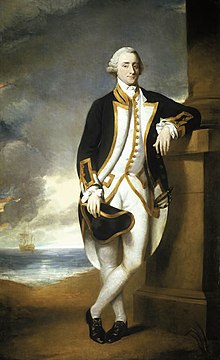Hugh Palliser
| Sir Hugh Palliser, Bt | |
|---|---|

|
|
| Born | 26 February 1723 Kirk Deighton, North Riding of Yorkshire, England, Great Britain |
| Died |
19 March 1796 (aged 73) Chalfont St Giles, Buckinghamshire, England |
| Allegiance |
|
| Service/branch |
|
| Years of service | 1735–1796 |
| Rank | Admiral |
| Commands held |
HMS Weazel HMS Captain HMS Sutherland HMS Sheerness HMS Yarmouth HMS Seahorse HMS Bristol HMS Eagle HMS Shrewsbury Channel Fleet Greenwich Hospital |
| Battles/wars |
|
Admiral Sir Hugh Palliser, 1st Baronet (26 February 1723 – 19 March 1796) was an officer of the British Royal Navy during the Seven Years' War and the American Revolutionary War. During the latter he came into a famous dispute with Augustus Keppel over the Battle of Ushant which led to Palliser being court-martialled, although he was subsequently acquitted.
Palliser was the only son of Hugh Palliser and Mary Robinson. at Kirk Deighton, in the West Riding of Yorkshire (now in North Yorkshire). The family had estates in Yorkshire and Ireland. His parents died when he was still young, so he and his sisters were (probably) raised by relatives on his mother's side. He entered the navy in 1735 as a midshipman on HMS Aldborough commanded by his uncle Nicholas Robinson. He followed his uncle to HMS Kennington in 1737, and then to HMS Tiger and HMS Essex.
Palliser passed his lieutenant's examination on 12 May 1741 and was promoted to the rank on 18 September 1741. He continued to serve aboard Essex, at first under Robinson, and after he was superseded, under Captain Richard Norris, the son of Sir John Norris. In February 1746 he was placed in command of HMS Weazel. On 25 November of that year he was appointed post-captain of HMS Captain, sailing for the West Indies with the broad pennant of Commodore Edward Legge. Legge died on 19 September 1747, and Palliser transferred to HMS Sutherland. Six months later an accidental fire in that ship's arms chest wounded Palliser; a ball entered his back and exited his groin; another ball struck his right hip; a third ball struck his left shoulder. Two other men were killed in the explosion. Palliser returned to England to recover, but remained lame in his left leg, and suffered perpetual and sometimes excruciating pain to which his death was eventually attributed.
...
Wikipedia
